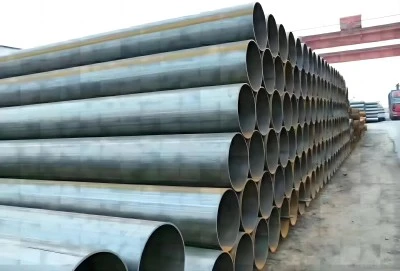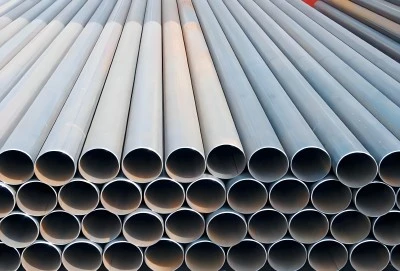Selecting the right EN10210 pipe grade is crucial for ensuring structural integrity and project success. The choice depends on factors like load-bearing requirements, environmental conditions, and cost considerations. For oil and gas transportation, water supply systems, and offshore platforms, engineers typically consider grades S235, S275, and S355. Each grade offers unique properties suited for different applications. By understanding these grades and considering project-specific factors, you can make an informed decision that balances performance, durability, and cost-effectiveness in your structural steel projects.
|
|
|
EN10210 Grades Explained: From S235 to S355
EN10210 S235: Properties and Applications
EN10210 pipe S235 is the entry-level grade in the EN10210 standard for hot-finished structural hollow sections. This grade offers a minimum yield strength of 235 MPa, making it suitable for various construction applications. S235 is known for its excellent weldability and formability, which are crucial in fabrication processes.
Applications for S235 include:
- Light to medium load-bearing structures
- Temporary constructions
- Non-critical components in larger structures
While S235 may not be the go-to choice for heavy-duty offshore platforms or high-pressure pipelines, it remains a cost-effective option for many general construction projects.
EN10210 S275: Balancing Strength and Weldability
Moving up the strength ladder, we find EN10210 S275. This grade offers a minimum yield strength of 275 MPa, providing a balance between increased strength and good weldability. S275 is often chosen when projects require more strength than S235 but don't necessarily need the high-performance characteristics of S355.
Key advantages of S275 include:
- Higher load-bearing capacity compared to S235
- Maintained weldability for ease of fabrication
- Cost-effective option for medium-duty applications
S275 finds its place in various industries, including building construction, bridge components, and some less demanding sections of oil and gas infrastructure.
S355: High-Strength Grade for Demanding Projects
At the top of the common EN10210 grades sits S355, boasting a minimum yield strength of 355 MPa. This high-strength grade is the preferred choice for demanding projects in the oil and gas sector, offshore platforms, and heavy industrial applications.
S355 offers several advantages:
- Superior strength-to-weight ratio
- Excellent fatigue resistance
- Capability to withstand high stresses and loads
While S355 comes at a higher price point, its performance in critical applications often justifies the investment, especially in projects where safety and reliability are paramount.
Environmental Factors in EN10210 Grade Selection
Corrosion Resistance: Choosing the Right EN10210 GradeWhen selecting EN10210 pipe grades, corrosion resistance is a critical factor, especially in harsh environments like offshore platforms or chemical processing plants. While the base grades (S235, S275, S355) offer similar corrosion resistance, additional treatments or alloy modifications can enhance this property.
For improved corrosion resistance:
- Consider weathering steel variants (e.g., S355J2W)
- Explore galvanization options for added protection
- Investigate corrosion-resistant coatings compatible with the chosen grade
In highly corrosive environments, stainless steel alternatives might be necessary, but these fall outside the standard EN10210 specification.
Temperature Considerations for EN10210 Pipe Selection
Temperature extremes can significantly impact the performance of EN10210 pipes. In cryogenic applications or high-temperature environments, careful grade selection is crucial.
For low-temperature applications:
- Choose grades with good low-temperature toughness (e.g., S355J2H)
- Consider impact testing requirements for your specific project
For high-temperature use:
- Evaluate the creep resistance of the chosen grade
- Consult with metallurgists for grades suitable for elevated temperatures
Impact of Chemical Exposure on EN10210 Grade Choice
Chemical exposure is a significant concern in many industrial applications. The choice of EN10210 grade can affect how well the pipe withstands various chemicals.
Considerations for chemical exposure:
- Assess the pH levels and chemical composition of potential exposures
- Evaluate the need for specialized coatings or linings
- Consider stainless steel options for extreme chemical environments
Always consult material compatibility charts and conduct thorough testing when chemical exposure is a concern in your project.
Cost vs Performance: Balancing EN10210 Material Choices
Analyzing Lifecycle Costs of Different EN10210 GradesWhen evaluating EN10210 pipe grades, it's essential to look beyond initial costs and consider the total lifecycle expenses. Higher-grade materials like S355 may have a steeper upfront cost but can offer significant long-term savings.
Factors influencing lifecycle costs:
- Maintenance requirements and frequency
- Expected lifespan of the structure
- Potential downtime costs for repairs or replacements
For example, using S355 in a corrosive environment might reduce the need for frequent replacements, ultimately proving more cost-effective than repeatedly installing lower-grade pipes.
Performance Benefits of Higher-Grade EN10210 Pipes
Higher-grade EN10210 pipes offer several performance advantages that can justify their increased cost in many applications.
Key benefits of higher-grade pipes:
- Increased load-bearing capacity allowing for lighter structures
- Better fatigue resistance in dynamic loading situations
- Improved performance in extreme temperatures
These benefits can lead to more efficient designs, reduced material usage, and enhanced overall project performance.
ROI Comparison: S235 vs S355 for Long-Term Projects
Comparing the return on investment (ROI) between different EN10210 grades requires careful consideration of project-specific factors.
ROI considerations:
- Initial material and fabrication costs
- Expected service life of the structure
- Maintenance and replacement schedules
- Potential for future load increases or environmental changes
In many long-term projects, especially those in demanding environments or with high safety requirements, the higher upfront cost of S355 can be offset by its superior performance and longevity.
Choosing the appropriate material grade for EN10210 steel pipe requires a comprehensive approach. Consider the specific requirements of your project, including load-bearing needs, environmental factors, and long-term cost implications. While S235 offers a cost-effective solution for less demanding applications, S275 provides a balanced option for medium-duty projects. For critical structures in harsh environments, S355 often proves to be the most suitable choice. Always consult with material experts and conduct thorough analyses to ensure your selection aligns with project goals and industry standards. By making an informed decision, you'll enhance the safety, efficiency, and longevity of your structural steel projects.
EN10210 Steel Pipes Supplier
For high-quality EN10210 pipes that meet rigorous industry standards, look no further than Hebei Longma Group. Our state-of-the-art production facilities, imported from Germany, ensure top-notch quality in every pipe we manufacture. With a professional team of over 300 employees, including 60+ technical experts, we guarantee precision and expertise in every order. Our comprehensive testing facilities, including ultrasonic flaw detectors and X-ray equipment, ensure each pipe meets the highest quality standards. We offer fast delivery, with standard thickness pipes ready in just 7 days. Backed by complete certifications including API 5L and ISO 9001, we provide reliable products for your most demanding projects. Our competitive pricing, made possible by long-term partnerships with raw material suppliers and efficient production processes, offers you the best value. For all your pipe needs, contact us at info@longma-group.com.














